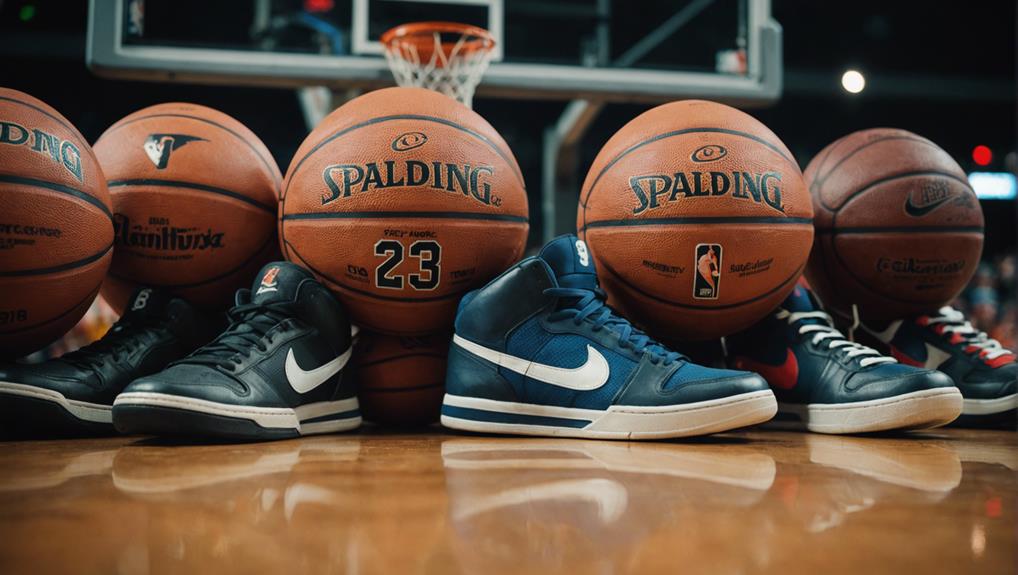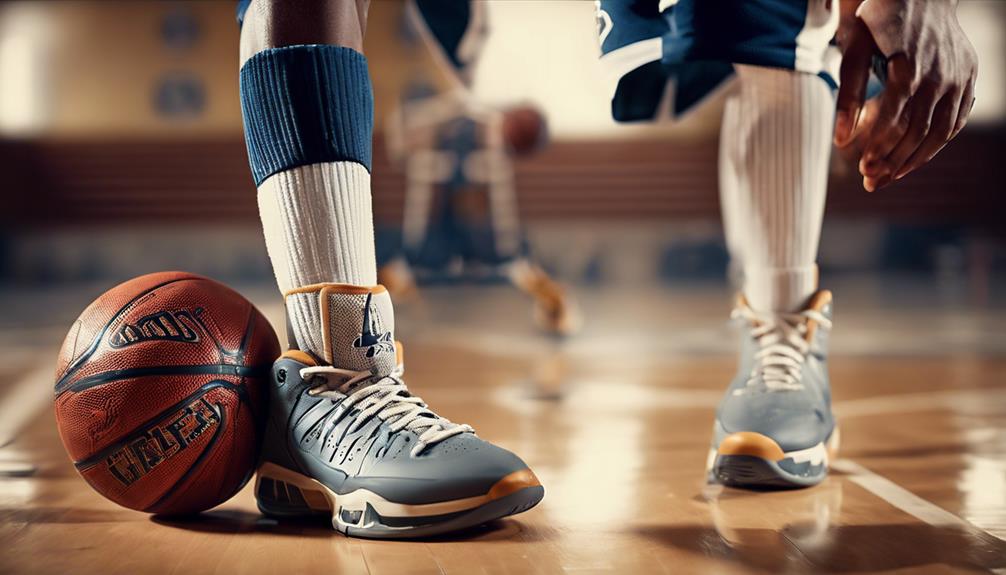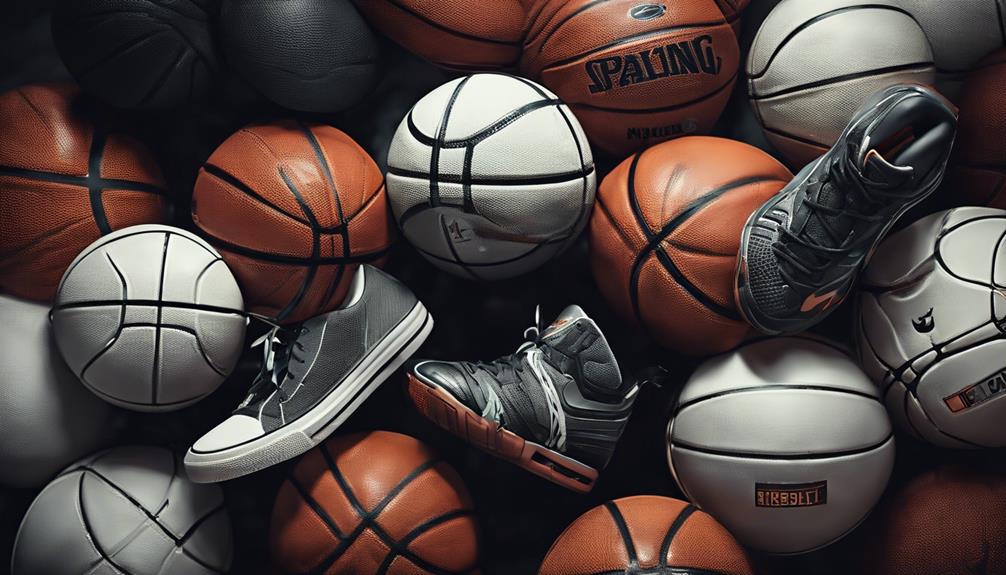
7 Tips for Evolution of Basketball Equipment Design
May 9, 2024To improve basketball equipment design, focus on lightweight materials for agility. Guarantee durable construction methods for longevity. Prioritize ergonomic design for comfort during gameplay. Innovate grip technology for better player control. Embrace advancements in aerodynamics for enhanced performance. Enhance impact resistance to secure player safety. Elevate user experience through adjustable features and moisture-wicking technology. Mastering these tips will boost player performance and safety on the court.
Lightweight Materials for Agility
Utilizing lightweight materials in basketball equipment design enhances player agility on the court by providing durability, flexibility, and minimized weight. When it comes to the evolution of basketball equipment, the shift towards using synthetic polyurethane leather and nylon 6-6 has greatly impacted player performance.
In the early days of basketball, leather basketballs were the norm, but they were heavy and absorbed moisture, affecting the game's consistency. As the game evolved, so did the materials used in basketball equipment. The introduction of synthetic polyurethane leather marked a turning point, offering improved durability, flexibility, and reduced weight compared to traditional leather basketballs. This innovation not only enhanced player agility but also increased the longevity of basketball covers, ensuring that the ball remains in excellent condition throughout the game.
Nylon 6-6 threads further reinforced the durability aspect, making basketball carcasses more resistant to wear and tear, especially in intense gameplay situations. The combination of these lightweight materials has revolutionized the way basketball equipment is designed, allowing players to move with ease and perform at their best from the first basketball games to the present day.
Durable Construction for Longevity
In order to guarantee the longevity of basketball equipment, prioritize utilizing high-quality materials like synthetic leather or composite leather for the basketball covers. These materials are known for their durability and resistance to wear and tear, ensuring that the basketball maintains its shape and performance over time.
Additionally, incorporating reinforced stitching and seams in the construction process further enhances the durability of the basketball, making it more resilient to the rigors of gameplay.
When it comes to the internal components of the basketball, advanced bonding techniques for the basketball bladder and carcass assembly are essential for preventing air leakage and maintaining ideal pressure levels. By using high-quality rubber bladder materials and ensuring a secure bond between the bladder and carcass, the basketball's longevity can be significantly prolonged.
Ergonomic Design for Comfort

When choosing basketball gear, consider features like supportive cushioning and adjustable closures for a comfortable fit that suits your playing style.
Look for materials that are breathable and moisture-wicking to keep you cool and dry during intense games.
Lightweight equipment can enhance your agility on the court without compromising durability.
Comfortable Fit Considerations
Consider incorporating padded cushioning in key areas of basketball shoes to enhance comfort during gameplay. By focusing on providing ample cushioning in the heel, midsole, and forefoot regions, players can experience reduced impact and increased comfort while running and jumping on the court.
Additionally, utilizing breathable materials in the shoe design allows for better ventilation, keeping the feet cool and dry during intense matches. Adjustable features like straps or laces enable athletes to customize the fit of their shoes, ensuring a secure and comfortable feel throughout the game.
Prioritizing comfort in basketball shoe design is essential for players to perform at their best without distractions or discomfort hindering their performance.
Supportive Cushioning Technology
With the evolution of basketball equipment design, embracing supportive cushioning technology has become a cornerstone for enhancing player comfort and performance on the court. Incorporating air cushioning technology in shoe soles reduces impact on joints, enhancing comfort during games.
Memory foam insoles that mold to the player's feet provide personalized support and cushioning. Lightweight materials with responsive cushioning properties improve agility and reduce fatigue during play.
Shock-absorbing gel technology in key areas of the shoe offers targeted support and protection. Moisture-wicking fabrics in shoe linings help regulate temperature and reduce friction for enhanced comfort.
These advancements in cushioning technology not only prioritize player comfort but also contribute to better performance on the basketball court, whether playing with leather basketballs or molded basketballs.
Innovation in Grip Technology
In basketball equipment design, the evolution of grip technology has greatly enhanced player performance and control on the court. The introduction of Spalding basketballs like the Cross Traxxion ball in 2006, featuring interlocking cross-shaped panels, has markedly improved grip. These advancements, shifting from four-panel to eight-panel basketballs, have revolutionized the way players handle the ball.
Incorporating microfiber material in modern basketballs has further boosted grip and consistency during gameplay. The innovations in grip technology have led to increased shooting accuracy and overall performance on the court. Players now experience better control and maneuverability, showcasing the impact of grip technology on the game.
As basketball equipment continues to evolve, grip technology remains an essential aspect in enhancing player experience and optimizing performance.
Advancements in Aerodynamics

Enhancing basketball equipment through advancements in aerodynamics has revolutionized player performance and overall gameplay experience on the court. Aerodynamics play a crucial role in optimizing the design of basketball equipment, such as balls and hoops, to enhance stability and performance during play.
Engineers have utilized aerodynamic principles to create basketballs with improved flight characteristics and consistent bounce, contributing to better shooting accuracy. By studying airflow patterns around basketballs, drag can be minimized, further enhancing the overall playing experience.
Additionally, designing basketball hoops with aerodynamic considerations not only reduces wind resistance but also increases net durability, ensuring longevity and reliability. In addition, incorporating aerodynamics into shoe design has been shown to boost player speed, agility, and overall performance on the basketball court.
These advancements in aerodynamics continue to push the boundaries of basketball equipment design, ultimately benefiting players and elevating the sport to new heights.
Focus on Impact Resistance
When considering impact resistance in basketball equipment, it's essential to focus on material innovation, safety standards, and durability testing.
Incorporating advanced shock-absorbing materials and technologies into various gear elements enhances player protection and equipment longevity.
Material Innovation
Utilizing cutting-edge impact-resistant materials has revolutionized the durability and performance of basketball equipment design. From the early days of Chuck Taylor's canvas sneakers to James Naismith's peach baskets, the evolution of materials like polyurethane and reinforced rubber has greatly enhanced the longevity of basketball gear.
Incorporating shock-absorbing technologies such as gel cushioning and air pockets in shoe soles reduces the strain on players' joints during intense gameplay. Advanced composite materials like carbon fiber and Kevlar have bolstered the strength and impact resistance of basketball hoops and backboards.
Innovations like foam padding and silicone gel inserts in uniforms offer essential impact protection. Exploring material combinations like memory foam with high-density polyethylene further optimizes both impact resistance and overall performance on the court.
Safety Standards
The evolution of basketball equipment design has significantly emphasized safety standards, particularly focusing on enhancing impact resistance to protect players from potential injuries. Impact resistance testing is important in ensuring basketball equipment meets safety standards in leagues like the National Basketball Association and college basketball to safeguard players during gameplay.
Materials such as high-density foam padding and shock-absorbing technologies are employed to improve impact resistance in gear like knee pads and shooting sleeves. Additionally, basketball hoops and backboards are constructed with impact-resistant materials like tempered glass or polycarbonate to endure player contact and ball impact.
Ongoing research and development efforts continue to prioritize enhancing impact resistance in basketball equipment to align with evolving safety standards and address player requirements effectively.
Durability Testing
How can basketball equipment designers guarantee longevity and safety during gameplay?
Durability testing, with a focus on impact resistance, plays a vital role. By subjecting equipment to rigorous impacts like ball hits and player collisions, designers simulate real game conditions.
To enhance impact resistance, advanced materials such as reinforced plastics, sturdy metals, and shock-absorbing foams are utilized. These materials help improve durability in components like backboards, rims, and shoes.
The evolution of basketball equipment design has come a long way from the sport's humble beginnings with peach baskets and the first player. Manufacturers conduct extensive testing to meet industry standards and ensure top performance, emphasizing the significance of durability in modern basketball equipment.
Enhancing User Experience
Enhance your basketball experience through the incorporation of ergonomic design principles that prioritize comfort and reduce fatigue during gameplay.
When designing basketball equipment, especially for high school players, it's essential to take into account the physical demands of the game. By utilizing advanced materials like synthetic leather and lightweight fabrics, manufacturers can improve durability and performance while ensuring players can move freely and comfortably on the court.
Additionally, integrating moisture-wicking technology helps keep players dry, maintaining a solid grip on the ball even during intense gameplay. Adjustable features such as straps and closures allow for a personalized fit, providing the support needed for peak performance.
Lastly, focusing on breathability and ventilation in the design helps regulate temperature, preventing overheating and ensuring players can stay focused throughout the game.
Conclusion
You've seen how basketball equipment design has evolved over the years to enhance performance and player experience.
With advancements in materials, construction, and technology, players can now enjoy lightweight, durable, and comfortable gear that improves their game.
The truth is, as technology continues to advance, basketball equipment will only get better, pushing players to new heights and sparking excitement for the future of the sport.


